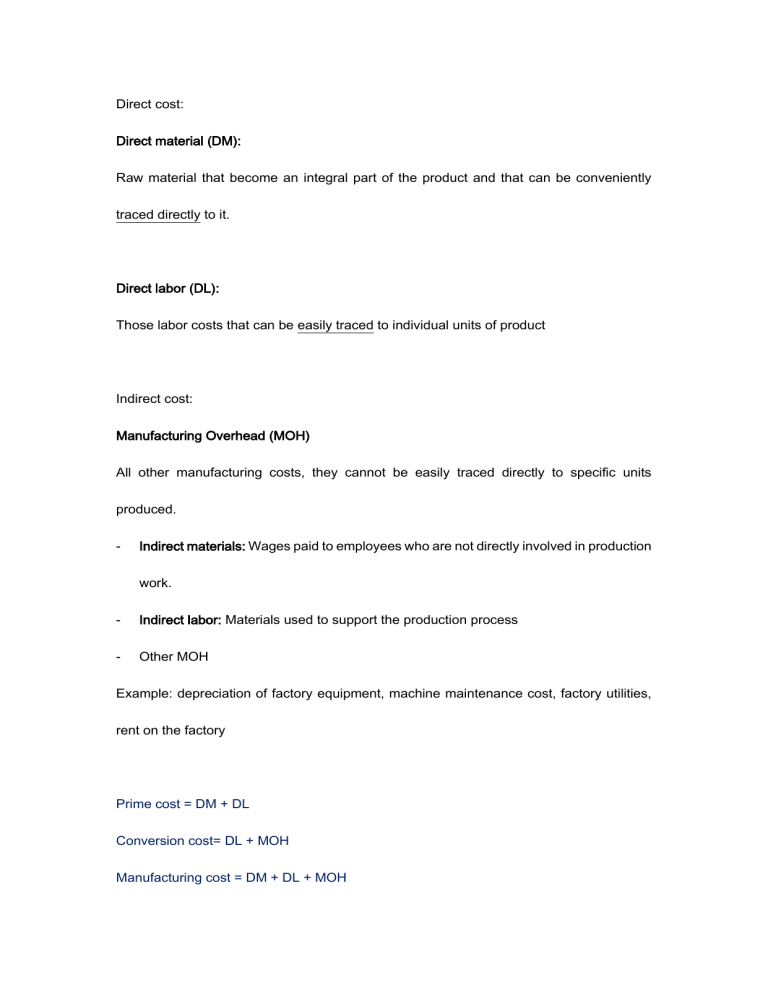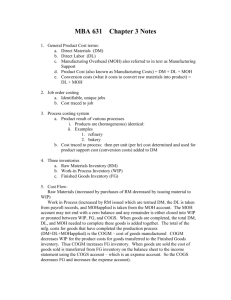
Direct cost: Direct material (DM): Raw material that become an integral part of the product and that can be conveniently traced directly to it. Direct labor (DL): Those labor costs that can be easily traced to individual units of product Indirect cost: Manufacturing Overhead (MOH) All other manufacturing costs, they cannot be easily traced directly to specific units produced. - Indirect materials: Wages paid to employees who are not directly involved in production work. - Indirect labor: Materials used to support the production process - Other MOH Example: depreciation of factory equipment, machine maintenance cost, factory utilities, rent on the factory Prime cost = DM + DL Conversion cost= DL + MOH Manufacturing cost = DM + DL + MOH Cost classification (Financial reporting purposes): - Manufacturing cost (Product cost): DM. DL, MOH - Non-Manufacturing cost (Period cost) = Selling cost + Administrative cost Selling cost: cost of selling the product Ex. Advertisement cost, Shipping cost, Sales commission Administrative cost: include all executives, organizations and clecal costs associated with the general management of an organization rather than making or selling the product. Ex. CEO salary, expenses of human resource department. Decision making - Differential cost: a different cost between two alternatives For example, two data plans. 1. You pay 60 per month for any usage below 15 GB. 2. You pay 10 per GB per month. Which option in better. If I only use the data on the phone occasionally for emergency purposes and will only use data below one GB per month, then cost option 1 is $60, while the cost of option 2 is $10. Differential cost = 60 – 10 = 50/month - Opportunity cost: the benefit that is sacrificed when one alternative is chosen over another. You could have earned $15,000 a year if you do not attend University, so the opportunity cost of attending university is $15,000 a year. - Sunk cost: Costs that have been incurred in the past and cannot be changed by any decision made now or in the future. For example, suppose you had purchased gold when it was worth $400 an ounce and that it is now worth only $250 an ounce. Should you wait until after the gold gets back above $400 before selling? The original cost $400 is a sunk cost and should be completely ignored. In deciding whether to sell the gold you should consider whether you need the cash now and the returns you expect to earn in the future from holding the gold as opposed to holding some other investment. Company Inc. Schedule of cost of goods manufactured For the year ended Direct material Beginning raw material inventory Add: Raw material purchases Raw material available for use Deduct: Ending raw material inventory Direct labor Manufacturing overhead Company Inc. Income statement For the year ended Sales Cost of goods sold Beginning finished goods inventory Add: Cost of goods manufactured Goods available for sale Deduct: Ending finished goods inventory Gross margin Less operating expense: Selling expenses Administrative expense Operating income Sales – COGS = Gross margin Gross margin – selling and administrative expenses = operating income Direct material (DM) Beg. Purchased End DM used Ending Bal. of Raw marterial = Beginning Bal. of Raw material + Purchase of RM – RM used Work-in-process (WIP) Beg. DM used COGM DL MOH End Ending Bal. of WIP = Beginning Bal. of WIP + DM used + DL + MOH COGM = Beginning Bal. of WIP + DM + DL + MOH – Ending Bal. of WIP Finished goods (FG) Beg. COGM COGS End Ending Bal. of finished good = Beginning cost of finished good + COGM – COGS COGS = Beginning cost of finished good + COGM - Ending Bal. of finished good


